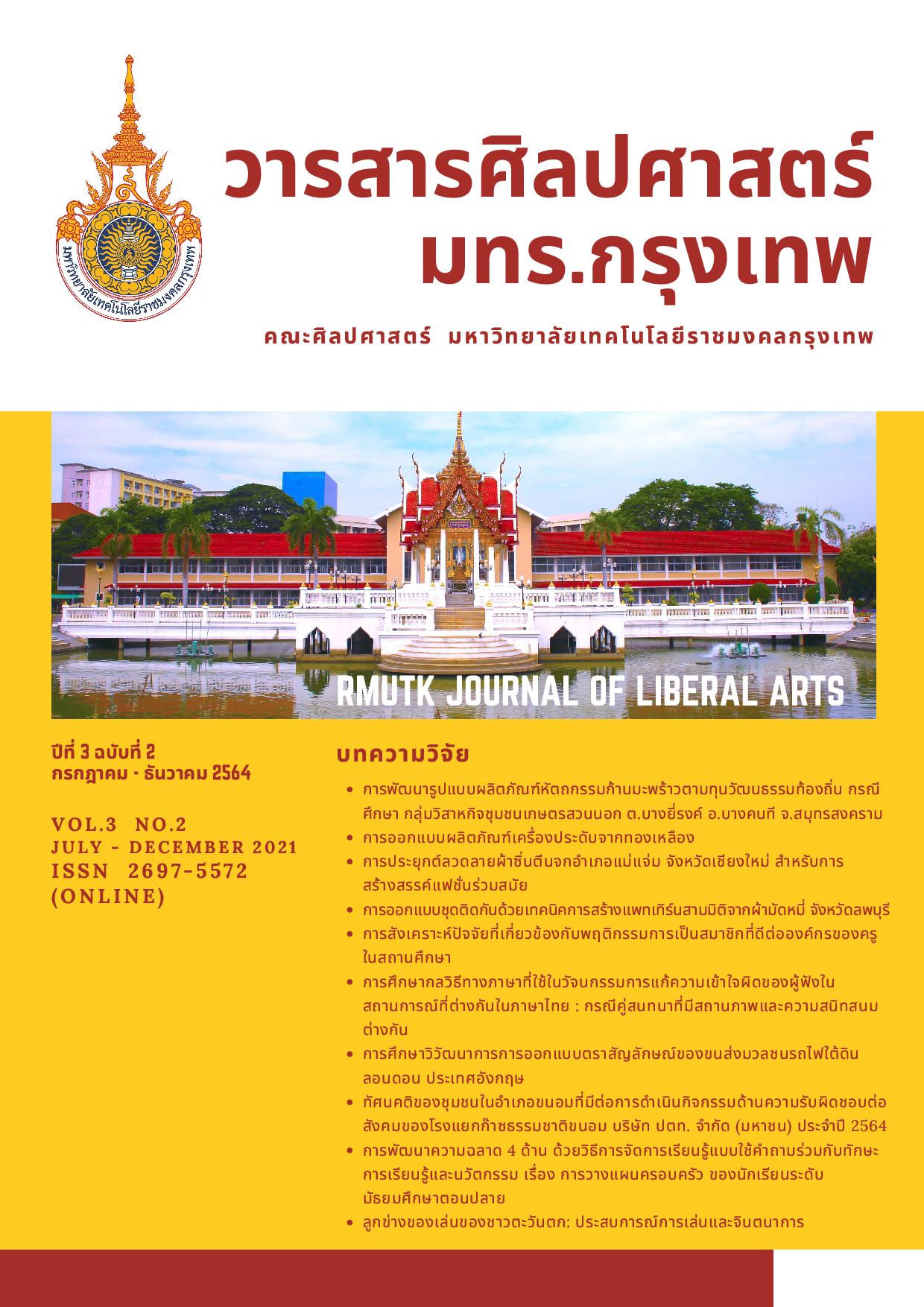THE DESIGN OF DRESS USING PATTERN MAGIC TECHNIQUES FROM MUDMEE FABRIC, LOPBURI PROVINCE
Main Article Content
Abstract
The objectives of the research project entitled ‘The Designing of Dress from Mudmee Fabric from Lopburi Province, with Pattern Magic Techniques, are 1) to design and make dresses from Mudmee (Thai Ikat) fabric from Lopburi Province, with Pattern Magic Techniques, and 2) to evaluate women’s satisfaction toward the dresses from Mudmee fabric from Lopburi Province, designed and made with Pattern Magic Techniques. The samples used in this research project are 40 female lecturers of Faculty of Home Economics Technology, Rajamangala University of Technology Krungthep. The research instrument used in this work is the questionnaire to draw the data of satisfaction. The samples are selected with purposive sampling technique. The data from the research are analyzed for statistic values, namely, percentages, means and standard deviations. The findings from the research show that Mudmee fabric has unique identities because it is woven from thread that is tied in sections and dyed in order to create the desirable graphics in desirable colors. Designed and made with Mudmee fabric and Pattern Magic Techniques, the dresses look dimensional and fit Mudmee fabric that has delicate graphics. In making dresses, it is essential to align the graphic of each piece of fabric to be continuous and clear. The Pattern Magic Techniques are applied to the designing and making of dresses from Mudmee fabric in 3 sets (9 designs in total) as follows: 1) Set A including the dresses made with fabric twisting technique, 2) Set B including the dresses made with weighing technique, and 3) Set C including the dresses made with flipping technique. The designed works from each set are selected by experts until there is 1 design per set. The results from the selection by the experts are as follows: Set A Design 2, Set B Design 1 and Set C Design 3. I, the researcher, apply the designs selected by the experts to making the prototype products and survey on the samples’s satisfaction with the dresses from Mudmee fabric designed and made with Pattern Magic Techniques. In the overview, the satisfaction of the samples is in ‘High’ level. Considered separately, Design 1 of Set B is the most satisfied one with the samples’ satisfaction in ‘Very High’ level for which the samples consider the factor of beauty to have the first priority, followed by the factors of design and function, respectively. The design in the second place is Design 2 of Set A with the samples’ satisfaction in ‘High’ level for which the samples consider the factor of design to have the first priority, followed by the factors of beauty and function, respectively. The design in the last place is Design 3 of Set C with the samples’ satisfaction in ‘High’ level for which the samples consider the factor of function to have the first priority, followed by the factors of beauty and design, respectively.
Article Details

This work is licensed under a Creative Commons Attribution-NonCommercial-NoDerivatives 4.0 International License.
References
กาญจนา บัวบุตร, สุธน กันดิษฐ์ และ อัมพร โสภารัตน์. (2552). การตกแต่งชุดทำงานสตรีด้วยผ้ายกเมืองนครศรีธรรมราช. (ปริญญานิพนธ์, มหาวิทยาลัยเทคโนโลยีราชมงคลกรุงเทพ).
กิตติกรณ์ นพอุดมพันธุ์. (2559). การสร้างสรรค์เสื้อผ้าเครื่องแต่งกายจากทฤษฎีการรื้อสร้าง (Deconstruction): กรณีศึกษาผ้าไหมมัดหมี่พื้นบ้าน อำเภอปักธงชัย จังหวัดนครราชสีมา. (ปริญญานิพนธ์, มหาวิทยาลัยศรีนครินทรวิโรฒ).
ดัสนีย์ สิงหวรเศรษฐ์. (2553). พื้นฐานการออกแบบสิ่งทอและแฟชั่น. กรุงเทพฯ: มหาวิทยาลัยเทคโนโลยีราชมงคลกรุงเทพ คณะอุตสาหกรรมสิ่งทอ.
ธานินทร์ ศิลป์จารุ. (2560). การวิจัยและวิเคราะห์ข้อมูลทางสถิติด้วย SPSS และ AMOS. (พิมพ์ครั้งที่ 17). กรุงเทพฯ: สามัญบิสซิเนสอาร์แอนด์ดี.
ธีร์ โคตรถา. (2562). แนวทางการสร้างสรรค์กลุ่มสินค้าแฟชั่นสำเร็จรูปด้วยหลักการเทคนิคเมจิกแพตเทิร์นสำหรับตลาดสินค้าแฟชั่นผู้สูงอายุในประเทศ. มหาวิทยาลัยเทคโนโลยีราชมงคลกรุงเทพ.
ผ้าทอมัดหมี่บ้านพวน. (ม.ป.ป.). สืบค้นจาก https://souvenirbuu.wordpress.com/%E0%B8% A0%E0%B8%
พรสวรรค์ แสงจันทร์. (2558). สีพฤกษาและลวดลายผ้าโบราณกับความงามบนผืนผ้ามัดหมี่ไทยพวนลพบุรี. (ปริญญานิพนธ์, บัณฑิตวิทยาลัย มหาวิทยาลัยศิลปากร).
มูลนิธิส่งเสริมศิลปาชีพ ในสมเด็จพระนางเจ้าสิริกิติ์ พระบรมราชินีนาถ. (2556). มัดหมี่ลายใหม่ที่ทรงเลือก. กรุงเทพฯ: แปล สารา จำกัด.
เยาวภา ปฐมศิริกุล, โชติรัส ชวนิชย์, เริ่ม ใสแจ่ม, และ รัฐพล สันสน. (2560). พฤติกรรมการซื้อและโอกาสการตัดสินใจซื้อสินค้ากลุ่มเสื้อผ้าและรองเท้าของลูกค้าสูงอายุในประเทศไทย. วารสารสมาคมนักวิจัย. 22(1), 178-192.
สมบัติ ประจญศานต์. 2562. โครงการถ่ายทดเทคนิคการออกแบบผสมผสานสีทางสายตาในผ้าไหมมัดหมี่ สินค้าทางวัฒนธรรมเพื่อส่งเสริมการท่องเที่ยว ในหมู่บ้านท่องที่ยวไหม จังหวัดบุรัรัมภ์. สำนักงานการวิจัยแห่งชาติ.
อรรถพนธ์ พงษ์เลาหพันธุ์. (2561). นวัตกรรมอัตลักษณ์ตราสินค้าแฟชั่นไลฟ์สไตล์สำหรับสตรีสูงวัย. (ปริญญานิพนธ์, คณะศิลปกรรมศาสตร์, จุฬาลงกรณ์มหาวิทยาลัย).
อรรภสิทธิ์ จันทร์นิเวศ. (2557). การศึกษาพัฒนารูปแบบผ้าทอดอกจอกแบบดั้งเดิม เพื่อนำไปสู่การพัฒนาสินค้าแฟชั่น กรณีศึกษาโครงการผ้าทอในพระบรมราชินูปภัมภ์ วัดน้ำเต้า อำเภอมหาราช จังหวัดพระนครศรีอยุธยา. (ปริญญานิพนธ์, คณะศิลปกรรมศาสตร์, มหาวิทยาลัยศรีนครินทรวิโรฒ).
Leung, Mai-ling Connie. (1999). Clothing need for elderly women. (Master’s thesis). Department of multidisciplinary studies, Institute of Textiles and Clothing, Hong Kong Polytechnic University.


